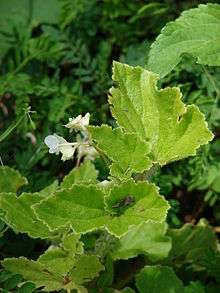Begoniaceae
Begoniaceae is a family of flowering plants with two genera and about 1825 species[2] occurring in the subtropics and tropics of both the New World and Old World.[3] All but one of the species are in the genus Begonia. The only other genus in the family, Hillebrandia, is endemic to the Hawaiian Islands and has a single species.[4] Phylogenetic work supports Hillebrandia as the sister taxon to the rest of the family.[4] The genus Symbegonia was reduced to a section of Begonia in 2003, as molecular phylogenies had shown it to be derived from within that genus.[5] Members of the genus Begonia are well-known and popular houseplants.
 Begonia flowers
Begonia flowers Begonia pseudolubbersii
Begonia pseudolubbersii
| Begoniaceae | |
|---|---|
 | |
| Begonia hirtella | |
| Scientific classification | |
| Kingdom: | Plantae |
| Clade: | Tracheophytes |
| Clade: | Angiosperms |
| Clade: | Eudicots |
| Clade: | Rosids |
| Order: | Cucurbitales |
| Family: | Begoniaceae C.Agardh[1] |
| Genera | |
 | |
| Range of the family Begoniaceae | |
References
- Angiosperm Phylogeny Group (2009). "An update of the Angiosperm Phylogeny Group classification for the orders and families of flowering plants: APG III". Botanical Journal of the Linnean Society. 161 (2): 105–121. doi:10.1111/j.1095-8339.2009.00996.x. Archived from the original on 2017-05-25.
- Christenhusz, M. J. M. & Byng, J. W. (2016). "The number of known plants species in the world and its annual increase". Phytotaxa. Magnolia Press. 261 (3): 201–217. doi:10.11646/phytotaxa.261.3.1.
- Laura Lowe Forrest, Mark Hughes & Peter M. Hollingsworth (2005). "A phylogeny of Begonia using nuclear ribosomal sequence data and morphological characters". Systematic Botany. 30 (3): 671–682. doi:10.1600/0363644054782297.
- Wendy L. Clement; Mark C. Tebbitt; Laura L. Forrest; Jaime E. Blair; Luc Brouillet; Torsten Eriksson; Susan M. Swensen (2004). "Phylogenetic position and biogeography of Hillebrandia sandwicensis (Begoniaceae): a rare Hawaiian relict". American Journal of Botany. 91 (6): 905–917. doi:10.3732/ajb.91.6.905. PMID 21653447.
- L. L. Forrest & P. M. Hollingsworth (2003). "A recircumscription of Begonia based on nuclear ribosomal sequences". Plant Systematics and Evolution. 241 (3–4): 193–211. doi:10.1007/s00606-002-0033-y.
Further reading
- Plana, Vanessa (2003). "Phylogenetic relationships of the Afro-Malagasy members of the large genus Begonia inferred from trnL intron sequences". Systematic Botany. 28 (4): 693–704. doi:10.1043/02-56.1 (inactive 2020-03-16).
This article is issued from Wikipedia. The text is licensed under Creative Commons - Attribution - Sharealike. Additional terms may apply for the media files.